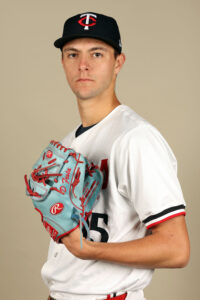June 27: The Twins have now formally announced the selection of Festa’s contract. He’ll make his debut today in Arizona. Right-hander Ronny Henriquez was optioned to St. Paul in a corresponding move.
June 26: The Twins are planning to select the contract of right-handed pitching prospect David Festa, reports Bobby Nightengale of the Star Tribune. KSTP’s Darren Wolfson first reported that Festa had been scratched as today’s starter in St. Paul, likely setting the stage for a debut tomorrow.
The 24-year-old Festa will indeed be called up ahead of Thursday’s series finale against the Diamondbacks in Arizona. Minnesota has an open spot on the 40-man roster, although the team will still need to make a corresponding move to add him to the 26-man roster. He will take over for a recently injured Chris Paddack in the Twins’ rotation. Most public outlets, including Baseball America, FanGraphs, and MLB Pipeline, agree that Festa is one of the Twins’ top two pitching prospects, with both MLB Pipeline (No. 99) and FanGraphs (no. 93) including the young right-hander among their top 100 prospects. He represented the Twins in the 2023 Futures Game.

The lanky 6’6″ Festa was a 13th-round pick by Minnesota out of Seton Hall back in 2021. He’s added considerable velocity to a heater that now sits around 95 mph and reaches the upper 90s since being drafted. He pairs that offering with a mid- to upper-80s slider that can get whiffs against righties and a changeup that helps him keep lefties at bay.
Scouting reports from each of BA, FanGraphs and MLB.com credit each of those three pitches as above-average, with the heater drawing a plus (60) from the latter. Though Festa started the season with some uncharacteristic walk troubles — he issued a free pass to 20% of his opponents over his first four Triple-A starts this season — he’s since reined in the walks and is credited with average or better command from scouts.
In 59 2/3 innings this season, Festa is sitting on a solid 3.77 earned run average that aligns quite closely with his 3.92 FIP. He’s punched out an excellent 35.1% of his opponents, and though his 9.7% walk rate is higher than average, Festa has made significant strides in that regard since his rocky start to the season. Over his past 10 outings, he’s only walked 6.7% of his opponents (while striking out an even loftier 37.3% of them).
The Twins view Festa as a potential key piece of their rotation for years to come, and they’ll get their first look at him tomorrow against the D-backs. While Paddack’s absence creates a short-term opening in the rotation, there’s not a clear vacancy once he returns from his bout of shoulder fatigue. Manager Rocco Baldelli indicated that the Twins plan to keep Paddack in a starting role when he’s reinstated, although given that this is Paddack’s first full season back from a second career Tommy John surgery (and that he’s already eclipsed his combined 2022-23 workload), an eventual move to a relief role later in the season seems plausible.
At that point, Festa could step into a more permanent spot in the rotation, at least for the remainder of the current season. All five of the Twins’ current starters — Paddack, Pablo Lopez, Joe Ryan, Bailey Ober and Simeon Woods Richardson — are signed/controlled through 2025 at the very least. Add in right-handers Louie Varland and Zebby Matthews (the Twins’ other top pitching prospect who ranks No. 99 at BA presently and boasts a combined 1.56 ERA and 76-to-3 K/BB ratio between High-A and Double-A this season), and the Twins have a budding and enviable stock of starting pitching depth on their hands.
That falls under the “good problem to have” umbrella, of course, and positions the team to withstand injuries or trade from a position of strength at next month’s deadline or in the coming offseason. Paddack will be a free agent following the 2025 season, but aside from that, the Twins’ entire collection of big league or near-MLB-ready starters is signed/controllable through at least 2027.
Turning back to Festa specifically, he won’t receive a full year of big league service in 2024, meaning he’ll still be controllable for at least six more seasons — all the way through 2030. He’s also being called up late enough in the year that even if he sticks on the roster, he won’t pick up enough time to reach Super Two status. At the earliest, he should be arbitration-eligible following the 2027 season, although future optional assignments could push back his timeline to both arbitration and free agency.